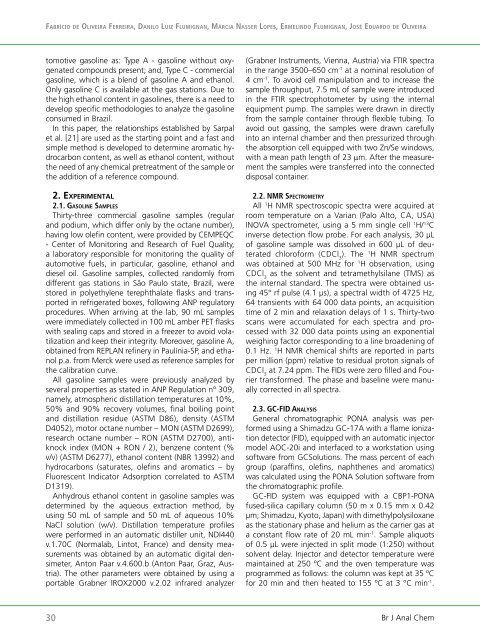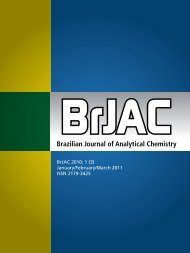Brazilian Journal of Analytical Chemistry - BRJAC - Brazilian Journal ...
Brazilian Journal of Analytical Chemistry - BRJAC - Brazilian Journal ...
Brazilian Journal of Analytical Chemistry - BRJAC - Brazilian Journal ...
Create successful ePaper yourself
Turn your PDF publications into a flip-book with our unique Google optimized e-Paper software.
Fab r í c i o de oliveira Fe r r e i r a, da n i l o lu i z Fl u m i g n a n, má r c i a nasser lo p e s, er m e l i n d o Fl u m i g n a n, Jo s é ed ua r d o de oliveira<br />
tomotive gasoline as: Type A - gasoline without oxygenated<br />
compounds present; and, Type C - commercial<br />
gasoline, which is a blend <strong>of</strong> gasoline A and ethanol.<br />
Only gasoline C is available at the gas stations. Due to<br />
the high ethanol content in gasolines, there is a need to<br />
develop specific methodologies to analyze the gasoline<br />
consumed in Brazil.<br />
In this paper, the relationships established by Sarpal<br />
et al. [21] are used as the starting point and a fast and<br />
simple method is developed to determine aromatic hydrocarbon<br />
content, as well as ethanol content, without<br />
the need <strong>of</strong> any chemical pretreatment <strong>of</strong> the sample or<br />
the addition <strong>of</strong> a reference compound.<br />
2. experImentAl<br />
2.1. ga s o l i n e sa m p l e s<br />
Thirty-three commercial gasoline samples (regular<br />
and podium, which differ only by the octane number),<br />
having low olefin content, were provided by CEMPEQC<br />
- Center <strong>of</strong> Monitoring and Research <strong>of</strong> Fuel Quality,<br />
a laboratory responsible for monitoring the quality <strong>of</strong><br />
automotive fuels, in particular, gasoline, ethanol and<br />
diesel oil. Gasoline samples, collected randomly from<br />
different gas stations in São Paulo state, Brazil, were<br />
stored in polyethylene terephthalate flasks and transported<br />
in refrigerated boxes, following ANP regulatory<br />
procedures. When arriving at the lab, 90 mL samples<br />
were immediately collected in 100 mL amber PET flasks<br />
with sealing caps and stored in a freezer to avoid volatilization<br />
and keep their integrity. Moreover, gasoline A,<br />
obtained from REPLAN refinery in Paulínia-SP, and ethanol<br />
p.a. from Merck were used as reference samples for<br />
the calibration curve.<br />
All gasoline samples were previously analyzed by<br />
several properties as stated in ANP Regulation nº 309,<br />
namely, atmospheric distillation temperatures at 10%,<br />
50% and 90% recovery volumes, final boiling point<br />
and distillation residue (ASTM D86), density (ASTM<br />
D4052), motor octane number – MON (ASTM D2699),<br />
research octane number – RON (ASTM D2700), antiknock<br />
index (MON + RON / 2), benzene content (%<br />
v/v) (ASTM D6277), ethanol content (NBR 13992) and<br />
hydrocarbons (saturates, olefins and aromatics – by<br />
Fluorescent Indicator Adsorption correlated to ASTM<br />
D1319).<br />
Anhydrous ethanol content in gasoline samples was<br />
determined by the aqueous extraction method, by<br />
using 50 mL <strong>of</strong> sample and 50 mL <strong>of</strong> aqueous 10%<br />
NaCl solution (w/v). Distillation temperature pr<strong>of</strong>iles<br />
were performed in an automatic distiller unit, NDI440<br />
v.1.70C (Normalab, Lintot, France) and density measurements<br />
was obtained by an automatic digital densimeter,<br />
Anton Paar v.4.600.b (Anton Paar, Graz, Austria).<br />
The other parameters were obtained by using a<br />
portable Grabner IROX2000 v.2.02 infrared analyzer<br />
(Grabner Instruments, Vienna, Austria) via FTIR spectra<br />
in the range 3500–650 cm -1 at a nominal resolution <strong>of</strong><br />
4 cm -1 . To avoid cell manipulation and to increase the<br />
sample throughput, 7.5 mL <strong>of</strong> sample were introduced<br />
in the FTIR spectrophotometer by using the internal<br />
equipment pump. The samples were drawn in directly<br />
from the sample container through flexible tubing. To<br />
avoid out gassing, the samples were drawn carefully<br />
into an internal chamber and then pressurized through<br />
the absorption cell equipped with two Zn/Se windows,<br />
with a mean path length <strong>of</strong> 23 µm. After the measurement<br />
the samples were transferred into the connected<br />
disposal container.<br />
2.2. nmr speCTromeTry<br />
All 1 H NMR spectroscopic spectra were acquired at<br />
room temperature on a Varian (Palo Alto, CA, USA)<br />
INOVA spectrometer, using a 5 mm single cell 1 H/ 13 C<br />
inverse detection flow probe. For each analysis, 30 µL<br />
<strong>of</strong> gasoline sample was dissolved in 600 µL <strong>of</strong> deuterated<br />
chlor<strong>of</strong>orm (CDCl 3 ). The 1 H NMR spectrum<br />
was obtained at 500 MHz for 1 H observation, using<br />
CDCl 3 as the solvent and tetramethylsilane (TMS) as<br />
the internal standard. The spectra were obtained using<br />
45° rf pulse (4.1 µs), a spectral width <strong>of</strong> 4725 Hz,<br />
64 transients with 64 000 data points, an acquisition<br />
time <strong>of</strong> 2 min and relaxation delays <strong>of</strong> 1 s. Thirty-two<br />
scans were accumulated for each spectra and processed<br />
with 32 000 data points using an exponential<br />
weighing factor corresponding to a line broadening <strong>of</strong><br />
0.1 Hz. 1 H NMR chemical shifts are reported in parts<br />
per million (ppm) relative to residual proton signals <strong>of</strong><br />
CDCl 3 at 7.24 ppm. The FIDs were zero filled and Fourier<br />
transformed. The phase and baseline were manually<br />
corrected in all spectra.<br />
2.3. gC-fid an a l y s i s<br />
General chromatographic PONA analysis was performed<br />
using a Shimadzu GC-17A with a flame ionization<br />
detector (FID), equipped with an automatic injector<br />
model AOC-20i and interfaced to a workstation using<br />
s<strong>of</strong>tware from GCSolutions. The mass percent <strong>of</strong> each<br />
group (paraffins, olefins, naphthenes and aromatics)<br />
was calculated using the PONA Solution s<strong>of</strong>tware from<br />
the chromatographic pr<strong>of</strong>ile.<br />
GC-FID system was equipped with a CBP1-PONA<br />
fused-silica capillary column (50 m x 0.15 mm x 0.42<br />
µm; Shimadzu, Kyoto, Japan) with dimethylpolysiloxane<br />
as the stationary phase and helium as the carrier gas at<br />
a constant flow rate <strong>of</strong> 20 mL min -1 . Sample aliquots<br />
<strong>of</strong> 0.5 μL were injected in split mode (1:250) without<br />
solvent delay. Injector and detector temperature were<br />
maintained at 250 ºC and the oven temperature was<br />
programmed as follows: the column was kept at 35 ºC<br />
for 20 min and then heated to 155 ºC at 3 °C min -1 .<br />
30 Br J Anal Chem



